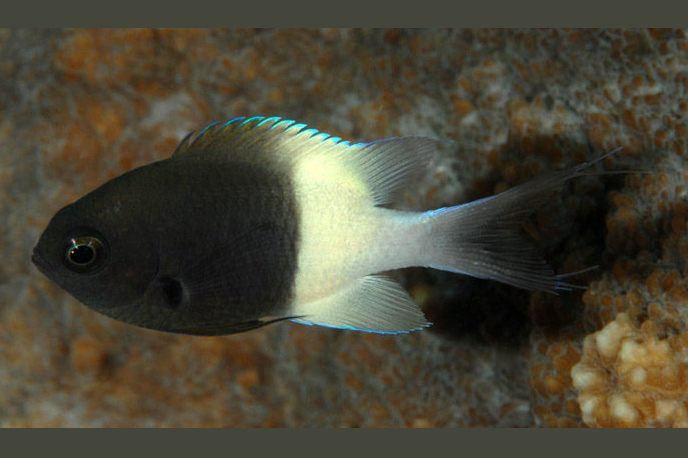Two-tone Puller, Pycnochromis fieldi (Randall & DiBattista 2013)
Other Names: Chocolate Dip Damselfish, Chocolate-dip Chromis, Half-and-half Chromis, Two-tone Chromis

A Two-tone Puller, Pycnochromis fieldi, in Sodwana Bay, South Africa. Source: Sally Polack / FishWise Professional. License: CC by Attribution-NonCommercial-ShareAlike
Summary:
A black and white puller with a slightly curved and indistinct delineation between the black and white body coloration: the white colour diffuses more anteriorly into the dorsal fin. The species also has a pale blue leading edge and margin on the dorsal fin, a pale bluish rear margin on the black axillary spot on the pectoral-fin base, faint dark longitudinal banding on the scale rows on the rear of the head, and faint bluish iridescence on the upper lip and suborbital bone.
This species was previously known as Chromis fieldi.
This species was previously known as Chromis fieldi.
Cite this page as:
Bray, D.J. 2023, Pycnochromis fieldi in Fishes of Australia, accessed 27 Jun 2025, https://fishesofaustralia.net.au/Home/species/4855
Two-tone Puller, Pycnochromis fieldi (Randall & DiBattista 2013)
More Info
|
Distribution |
Widespread in the Indian Ocean from East Africa to Indonesia, including the Australian territories of Cocos (Keeling) Islands and Christmas Island in the eastern Indian Ocean. Inhabits lagoons and outer reefs, although not in areas exposed to heavy wave action. The species sometimes forms large feeding aggregations just above the reef along the rim of dropoffs. |
|
Features |
Dorsal fin XII,12-13; Anal fin II,12-14; Pectoral fin 16-17; Principal caudal-fin rays 15; Upper and lower procurrent caudal rays 4, anterior 2 spiniform; Longitudinal scale series 27; Lateral-line scales 16-17; Gill rakers 7-9 + 19-21. Body depth 2.2-2.35 in SL; head length 3.15-3.35 in SL; snout short, rounded, 3.1-3.3 in SL. Caudal fin strongly forked, second and third, and fourteenth and fifteenth principal caudal rays with filamentous branched tips, especially long in third and fourteenth rays; first soft ray of pelvic fins filamentous; soft dorsal and anal rays all branched, the last to base. |
|
Colour |
Pale blue on the leading edge of the dorsal and anal-fin spines and along the margin of the anterior soft portion of the median fins, bluish white posterior margin of the black axillary spot, faint dark longitudinal banding on the rows of scales of the postorbital head; also a faint bluish irridescence on the upper lip and suborbital. |
|
Feeding |
Feeds on zooplankton in the water column just above the reef. |
|
Similar Species |
Similar to the Half-and-half Puller, Chromis iomelas, which occurs in the Western Pacific from the Great Barrier Reef, Australia, north to Papua New Guinea, New Caledonia, Vanuatu, Fiji, Samoa, Society Islands and the Tuamotos. C. iomelas is not found north of New Guinea, nor in the islands of Micronesia. C. iomelas has 12 dorsal-fin spines (vs 13-14 in C. fieldi) and the dark/light demarcation occurs before the anal-fin origin, and the tips of the pectoral fins extend into the white area in C. iomelas. C. fieldi differs from the Red Sea endemic C. dimidiata in having 17 pectoral-fin rays and 17 tubed lateral line scales (vs modally 15 for C. dimidiata), and the dark brown/white demarcation is relatively straight in C. dimidiata vs more convex in C. fieldi. |
|
Etymology |
Named in honour of Richard Field, the first to suspect that the Indian Ocean population of Chromis dimidiata might represent a different species. |
|
Species Citation |
Chromis fieldi Randall & DiBattista 2013, aqua, International Journal of Ichthyology 19(1): 5, Figs. 4-9. Type locality: West coast off Medine (north of Flic en Flac), Mauritius, depth 30 m. |
|
Author |
Bray, D.J. 2023 |
|
Resources |
Two-tone Puller, Pycnochromis fieldi (Randall & DiBattista 2013)
References
Allen, G. R. 2001. Family Pomacentridae. pp. 3381-4218 in Carpenter, K.E. & Niem, T.H. (eds). The Living Marine Resources of the Western Central Pacific. FAO Species Identification Guide for Fisheries Purposes. Rome : FAO Vol. 6. (as Chromis dimidiata)
Allen, G.R. & Erdmann, M.V. 2012. Reef fishes of the East Indies. Perth : Tropical Reef Research 3 vols, 1260 pp. (as Chromis dimidiata)
Allen, G.R., Steene, R.C. & Orchard, M. 2007. Fishes of Christmas Island. Christmas Island : Christmas Island Natural History Association 2 edn, 284 pp. (as Chromis dimidiata)
Allen, G.R. & Steene, R.C. 1987. Reef fishes of the Indian Ocean. A pictorial guide to the common reef fishes of the Indian Ocean. Neptune City, New Jersey : T.F.H. Publications 240 pp. (as Chromis dimidiata)
Hobbs, J-P.A., Newman, S.J., Mitsopoulos, G.E.A., Travers, M.J., Skepper, C.L., Gilligan, J.J., Allen, G.R., Choat, H.J. & Ayling, A.M. 2014. Checklist and new records of Christmas Island fishes: the influence of isolation, biogeography and habitat availability on species abundance and community composition. Raffles Bulletin of Zoology Supplement 30: 184–202 https://lkcnhm.nus.edu.sg/rbz/supplement-no-30/ (as Chromis fieldi)
Randall, J.E. 2005. Reef and shore fishes of the South Pacific. New Caledonia to Tahiti and the Pitcairn Islands. Honolulu : University of Hawaii Press 707 pp. (as Chromis dimidiata)
Randall, J.E. & J.D. DiBattista. 2013. A new species of damselfish (Pomacentridae) from the Indian Ocean. aqua, International Journal of Ichthyology 19(1): 1-16. See ref online
Tang, K.L., Stiassny, M.L.J., Mayden, R.L. & DeSalle, R. 2021. Systematics of Damselfishes. Ichthyology & Herpetology 109(1): 258-318. https://doi.org/10.1643/i2020105





